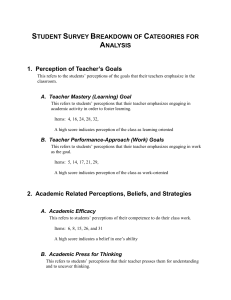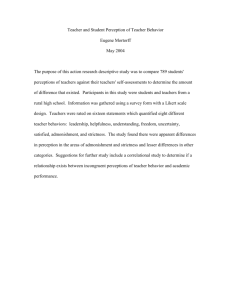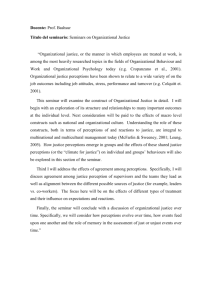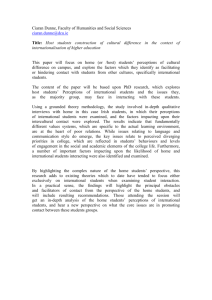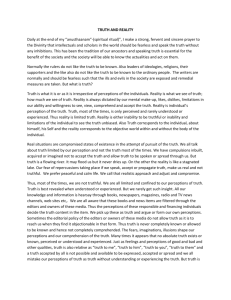THE MIRROR HAS TWO FACES: AN EXPERIENTIAL EXERCISE IN
advertisement
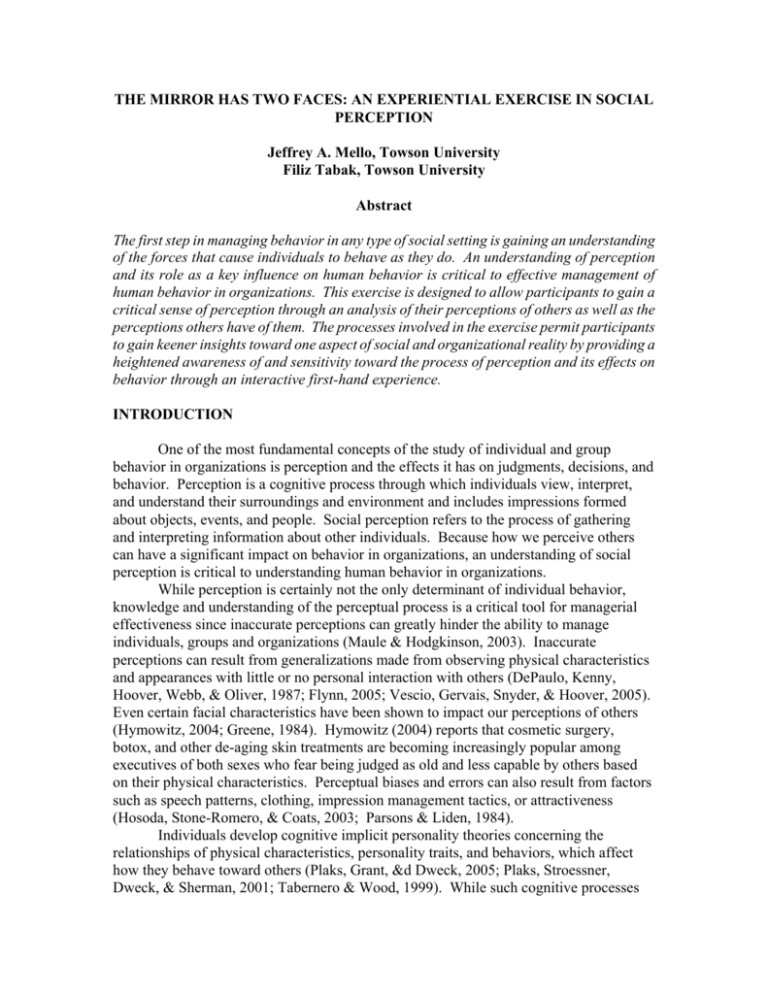
THE MIRROR HAS TWO FACES: AN EXPERIENTIAL EXERCISE IN SOCIAL PERCEPTION Jeffrey A. Mello, Towson University Filiz Tabak, Towson University Abstract The first step in managing behavior in any type of social setting is gaining an understanding of the forces that cause individuals to behave as they do. An understanding of perception and its role as a key influence on human behavior is critical to effective management of human behavior in organizations. This exercise is designed to allow participants to gain a critical sense of perception through an analysis of their perceptions of others as well as the perceptions others have of them. The processes involved in the exercise permit participants to gain keener insights toward one aspect of social and organizational reality by providing a heightened awareness of and sensitivity toward the process of perception and its effects on behavior through an interactive first-hand experience. INTRODUCTION One of the most fundamental concepts of the study of individual and group behavior in organizations is perception and the effects it has on judgments, decisions, and behavior. Perception is a cognitive process through which individuals view, interpret, and understand their surroundings and environment and includes impressions formed about objects, events, and people. Social perception refers to the process of gathering and interpreting information about other individuals. Because how we perceive others can have a significant impact on behavior in organizations, an understanding of social perception is critical to understanding human behavior in organizations. While perception is certainly not the only determinant of individual behavior, knowledge and understanding of the perceptual process is a critical tool for managerial effectiveness since inaccurate perceptions can greatly hinder the ability to manage individuals, groups and organizations (Maule & Hodgkinson, 2003). Inaccurate perceptions can result from generalizations made from observing physical characteristics and appearances with little or no personal interaction with others (DePaulo, Kenny, Hoover, Webb, & Oliver, 1987; Flynn, 2005; Vescio, Gervais, Snyder, & Hoover, 2005). Even certain facial characteristics have been shown to impact our perceptions of others (Hymowitz, 2004; Greene, 1984). Hymowitz (2004) reports that cosmetic surgery, botox, and other de-aging skin treatments are becoming increasingly popular among executives of both sexes who fear being judged as old and less capable by others based on their physical characteristics. Perceptual biases and errors can also result from factors such as speech patterns, clothing, impression management tactics, or attractiveness (Hosoda, Stone-Romero, & Coats, 2003; Parsons & Liden, 1984). Individuals develop cognitive implicit personality theories concerning the relationships of physical characteristics, personality traits, and behaviors, which affect how they behave toward others (Plaks, Grant, &d Dweck, 2005; Plaks, Stroessner, Dweck, & Sherman, 2001; Tabernero & Wood, 1999). While such cognitive processes can serve the purpose of helping individuals better understand their world, these processes can also result in a variety of perceptual errors and conflict (Janis, 2001). Due to the fact that in organizations both managers and subordinates often generalize and stereotype in an attempt to get to know the "whole person" in an expeditious manner, perceptions made are often biased, if not totally erroneous. A good deal of the behavior that may seem "unexplained" or "out of character" in any social setting can often be the result of such perceptual errors (Maule & Hodgkinson, 2003). It is critical for those who manage people to understand that no individual's perceptions are necessarily accurate interpretations of his/her environment, but unique interpretations based on select information and observations that vary from individual to individual. Consequently, rational behavior, as seen by one individual, may appear irrational to another due to differences in perception. Given that the behavior of one individual is often the stimulus for another's behavior, one simple perceptual error that becomes manifest in a behavior has the potential via a "chain reaction" effect to seriously hinder communication and coordination and detrimentally influence interpersonal relationships and group dynamics. Given all that we know about perception, organizational behavior texts generally present a very comprehensive overview of the perception process. However, while students can understand and learn concepts, this knowledge is of little significance and practical value if students are not able to examine their own perceptions and tendencies to make perceptual errors. We have found that, in teaching perception, students can generally find examples of their own past perceptual errors quite readily yet do not take the time to understand how these errors were formed or their implications for their own behavior and the behavioral responses of others. The purpose of this paper is to present an experiential exercise that provides students with an opportunity to experience and analyze perception in a social setting from both an active and a passive position. Participants are divided into groups of five (four and six are also possible, but five seems to be optimal) and are asked to write down selfperceptions. Upon completing this task, they write down selected perceptions of their group members. Students then share their perceptions with group members and discuss the process by which their perceptions were formed. The main objectives of the exercise are 1) to allow students to gain a greater understanding of how they form perceptions and what perceptual errors they tend to make, 2) to allow students to see how others perceive them and the "cues" that they consciously or unconsciously communicate to others that result in such perceptions, and 3) to examine the effects that the following variables have in the formation of perception: characteristics of the perceiver, characteristics of the person being perceived, and the situation/context in which perception takes place. THE EXERCISE The exercise is divided into five separate sequential steps, as follows: Step 1 Students are allowed to self-select into groups of five, told to seat themselves in proximity to their group members and instructed to exchange names with each other if they do not already know each others’ names. Step 2 (5 minutes) Students then receive the worksheet presented in Exhibit 1 and are instructed to position themselves in their seats so that no one can see what they are writing (i.e., turn away from their group members). They are then told to think about themselves and how they envision themselves. They then write the most dominant impression they have of themselves or the "first thing that comes to mind" (generally an adjective) when they think of themselves in the appropriate space on the worksheet under their name (i.e. “self”). They are then asked to ponder the question "If you were an animal, what kind of animal would you be?" and enter their response accordingly. They are then asked to list their favorite television show, food, and hobby in the appropriate spaces. Step 3 (15-20 minutes) Upon completion of Step 2, students are instructed to remain isolated from group members and to enter each group member's name at the top of the remaining columns of the worksheet. They are then told to repeat the procedure from Step 2 for each of their group members. In other words, they should enter their most dominant impression of each group member, disclose what kind of animal each group member would be if (s)he were an animal, and state what they think are each of their group members’ favorite television show, food and hobby. Students should be advised that this is an individual exercise and that they should not converse with others or look at others' papers. They should also be encouraged to be as honest as possible although the instructor may warn them that they will be sharing their responses with group members and they should exercise tact and sensitivity to avoid any potentially embarrassing or hurtful disclosures or situations. Step 4 (20-30 minutes) Once all students in the class have completed their worksheets, students are then instructed to share their perceptions with group members as well as to share their explanations as to what caused them to arrive at the answers they did. A variety of procedures can be used to have students share their responses. One is categorically active where students, one at a time, read their perceptions of themselves and others by perception. Another is individually active where each student reads all of his/her perceptions of each group member, one by one. An individually passive procedure can also be used where each student listens to each of his/her group members' perceptions of him/her. We generally allow the groups to decide how they wish to proceed in this regard but emphasize that regardless of how they disclose their perceptions they should explain what caused them to perceive others in the manner in which they did. Step 5 (20-30 minutes inside class or can be complete as a take-home assignment) Upon completion of the group discussion, students are then instructed to respond in writing to the questions presented in Exhibit 2 which are later used to direct the class discussion of the exercise. Although we don't collect and read the responses, we find that forcing students to write down answers results in their giving the questions more thought and their being more prepared for and responsive during the class discussion and debriefing. In having students write about the accuracy of their perceptions of others and to what these accuracies and inaccuracies can be attributed, the goal is for students to gain an understanding about how they form perceptions of others and how these perceptions are influenced by personal and/or situational factors. Indeed, how we describe another person may also tell us a good deal about ourselves (Battistich, Assor, Meese, & Aronoff, 1985; Hampson, 1984). Making individuals aware of their own perceptual processes is the first step in attempting to minimize future perceptual errors as well as providing them with the opportunity to develop a heightened self-awareness (Fletcher & Bailey, 2003; Hull, Slone, Meteyer, & Matthews, 2002; Moshavl, Brown, & Dodd, 2003; Simon, Hastedt, & Aufderheide, 1997). Once self-awareness is raised and individuals become aware of their perceptual errors, it becomes possible to overcome them (Cardy & Kehoe, 1984). In having students write about the accuracy of others' perceptions of them and to what these accuracies and inaccuracies can be attributed, the goal is for students to gain an understanding of how others perceive them and how such perceptions may be influenced by many nonverbal cues which they give off both consciously and unconsciously. It ideally allows students to understand the uniqueness of the perceptual process from individual to individual by seeing first-hand how others form perceptions based on varied factors and that perceptions are not necessarily "right" or "wrong" (although they may be "accurate" or "inaccurate") as they represent personal interpretations of realities or social stereotypes (Ashton & Esses, 1999; Quinn & McRae, 2005). Indeed, how we perceive others is, in part, a function of our own personality, values, attitudes, and past experiences as well as the characteristics of the target and the characteristics of the situation (Nelson & Quick, 2006). DISCUSSION We generally cover perception during the fourth meeting of the survey organizational behavior course. Hence, the exercise can also serve the function of being an "ice breaker" of sorts. The exercise further allows students the opportunity to work with classmates temporarily shortly before they self-select into permanent groups for the remainder of the academic term. Prior to the perception segment of the course, students have been exposed to the topics of personality differences, Jungian cognitive styles and the general nature of individual differences and the resulting effects these differences can have on human behavior. Upon completing the exercise we ask students if they can determine its purpose. They consistently hit the nail right on the head in identifying the objective of how they form their own perceptions of others. They are slower to realize the more passive objective of how others form perceptions of them but quickly acknowledge this purpose once it is presented to them. The discussion then progresses to exploring responses students have to the discussion questions about their experience with the exercise. This generally leads to a discussion of the power of personal appearance in its effect on perceptions of those we do not know as well as how certain factors from earlier class meetings (such as late arrivals, verbal responses, dimensions of voice, where someone sits, an individual’s dress, etc.) affected perceptions. Students are often surprised and also reassured in finding that classmates had similar feelings in responding to the discussion questions relative to how their own perceptions were formed (i.e., that they often based their initial perceptions on stereotypes or generalizations). This discussion can be extended to ask students whether they were in groups with some students they previously knew and some they did not as to whether their perceptions of prior acquaintances were more accurate. If that is so, we discuss to what that can be attributed and also discuss the effects that situations can have on perceptions. Discussion can also focus on the difference between the more opinionated perceptions (first thing to mind and animal) versus the more concrete perceptions (TV show, food, and hobby). In short, the post-exercise discussion can be as general or detailed as the instructor wishes, given the learning objectives for the class and time constraints. Instructors using this exercise should be prepared to discuss stereotypes based on a variety of individual factors, including, but not limited to, gender and race. We have found, in more than twenty years of using this exercise, that, for example, females are often perceived by both males and their female colleagues as smaller, gentle animals. Asian-Americans are very frequently perceived to favor Asian cuisine. AfricanAmericans are perceived to watch sitcoms which feature African-American casts. Such disclosures can result in a valuable discussion not only of stereotypes but of impression management. Students can learn which factors outside of their control can cause individuals who don’t know them to assume certain things about them as well as how they can develop strategies to dispel these perceptions. For those instructors who require students to maintain journals, this exercise provides an excellent opportunity for some timely and meaningful introspective writing. We have graduate students write about the exercise as a portion of an introspective midterm paper. The extent to which the instructor wishes to utilize the exercise in this context might affect the nature and depth of the in-class discussion conducted. This exercise has also been used quite successfully in student groups ranging from traditional undergraduates to Executive MBA students. A critical factor in its success is the extent to which the instructor makes it more than just another "O.B. game." It is possible to have an extremely rich classroom discussion facilitating self-disclosure and true experiential learning if the exercise is managed properly. While it can and will be "fun" for students to participate in, it can allow students to gain insights into the perceptual process that cannot be obtained from cases or textbooks alone. It can be and is designed to be much more than an exercise in first impressions although such primacy effects have been found to have an important and ongoing effect on perception (Miller, Westerman, & Lloyd, 2004; Penrod, 1983). It should be noted that the five perceptions that students are asked to make are flexible. An instructor could decide to eliminate one particular perception, television show, for example, and replace it with another, such as favorite recording artist, magazine, vacation destination, type of car driven, etc. This can aid in making the exercise more appropriate for different groups. Toward this end we have used “favorite recording artist” for undergraduates and “type of car driven” for executive MBAs. The general concept of experiential exercises related to person perception is not new. Such a pedagogy first appeared in 1971 (Kolb, Rubin & McIntyre, 1971) and, over the years evolved with some variations (e.g., Brew, 2002; Duff, 2004; Mainemelis, Boyatzis, & Kolb, 2002; Stein, 2004). However, the distinctive contribution of this exercise is its process. As noted above, the class discussion based on the writing portion of the assignment is innovative and critical to the success of the exercise. It will ideally allow students to gain a far greater understanding of the perceptual process than can be gained through textbook reading and case studies but, more importantly, provide them with a critical tool for understanding and managing their own behavior as well as that of their employees and co-workers. REFERENCES Ashton, M. C., & Esses, V. M. (1999). Stereotype accuracy: Estimating the academic performance of ethnic groups. Personality and Social Psychology Bulletin, 22536. Battistich, V., Assor, A., Meese, L. A., & Aronoff, J. (1985). Personality and Person Perception. In P. Shaved (ed.), Self, Situations, and Social Behavior. (pp. 185208) Beverly Hills, Ca: Sage. Brew, C. R. (2002). Kolb's learning style instrument: Sensitive to gender. Educational & Psychological Measurement, 62, 2, 373-390. Brigham, J. C. (1986). Social Psychology. Boston: Little, Brown. Cardy, R. L., & Kehoe, J. F. (1984). Rater selective attention ability and appraisal effectiveness: The effect of a cognitive style on the accuracy of differentiation among ratees. Journal of Applied Psychology, 69, 589-594. DePaulo, B.M., Kenny, D. A., Hoover, C.W., Webb, W. & Oliver, P.V. (1987) Accuracy of Person Perception: Do People Know What Kinds of Impressions They Convey? Journal of Personality and Social Psychology, 52, 303-315. Duff, A. (2004). A Note on the Problem Solving Style Questionnaire: An alternative to Kolb's Learning Style Inventory? Educational Psychology, 24, 5, 699-709. Fletcher, C., & Bailey, C. (2003). Assessing self-awareness: Some issues and methods. Journal of Managerial Psychology, 18, 5, 395-405. Flynn, F. J. (2005). Having an Open Mind: The Impact of Openness to Experience on Interracial Attitudes and Impression Formation. Journal of Personality and Social Psychology, 88, 5, 816-826. Greene, R. (1984, November 5) Jury Tempering. Forbes, pp. 214-218. Hampson, S.E. (1984). Personality Traits: In the Eye of the Beholder or the Personality of the Perceived? In M. Cook (ed.), Issues in Person Perception. (pp.28-47) London: Methuen. Hull, J. G., Slone, L. B., Meteyer, K. B., & Matthews, A. R. (2002). The nonconsciousness of self-consciousness. Journal of Personality and Social Psychology, 83, 2, 406-424. Hymowitz C. (2004). Top executives chase youthful appearance, but miss real issue. The Wall Street Journal, Feb. 17, 2004, p. B1, from Wall Street Journal, Eastern Edition, copyright 2004, by Dow Jones & Co. Inman, M. L., & Baron, R. S. (1996). Influence of prototypes on perceptions of prejudice. Journal of Personality and Social Psychology, 70, 4, 727-739. Janis, M. (2001). In the eye of the beholder: Using perceptual errors to resolve employment disputes. Dispute Resolution Journal, 56, 3, 48-56. Kolb, D. A., Rubin, I.M., & McIntyre, J.M. (1971). Organizational Psychology: An Experiential Approach Englewood Cliffs, NJ: Prentice-Hall. Mainemelis, C., Boyatzis, R. E. & Kolb, D. A. (2002). Learning styles and adaptive flexibility: Testing experiential learning theory. Management Learning, 33, 1, 533. Maule, A. J., & Hodgkinson, G. P. (2003). Re-appraising managers' perceptual errors: A behavioural decision-making perspective. British Journal of Management, 14, 1, 33-37. Megumi H., Stone-Romero, E. F., & Coats, G. (2003). The effects of physical attractiveness on job-related outcomes: A meta-analysis of experimental studies. Personnel Psychology, 56, 2, 431-462. Mezias, J. M., & Starbuck, W. H. (2003). Studying the accuracy of managers' perceptions: A research odyssey. British Journal of Management, 14, 1, 3-17 Michener, H.A., DeLamater, J.D., & Schwartz, S.H. (1986). Social Psychology. New York: Harcourt Brace Jovanovich. Miller, J. K., Westerman, D. L. & Lloyd, M. E. (2004). Are first impressions lasting impressions? An exploration of the generality of the primacy effect in memory for repetitions. Memory & Cognition, 32, 8, 1305-1315. Moshavl, D., Brown, F. W., & Dodd, N. G. (2003). Leader self-awareness and its relationship to subordinate attitudes and performance. Leadership & Organization Development Journal, 24, 7/8, 407-419. Nelson, D., & Quick, J. C. (2006). Organizational Behavior: Foundations, Realities, & Challenges. 5th Edition. Southwestern/Thomson Publishing. Parsons, C.K., & Liden, R.C. (1984). Interviewer perceptions of applicant qualifications: A multivariate study of demographic characteristics and nonverbal cues. Journal of Applied Psychology, 69, 4, 557-568 Penrod, S. (1983). Social Psychology. Englewood Cliffs, NJ: Prentice-Hall. Plaks, J. E., Stroessner, S. J., Dweck, C. S., & Sherman, J. W. (2001). Person theories and attention allocation: Preferences for stereotypic versus counter-stereotypic information. Journal of Personality and Social Psychology, 80, 6, 876-893. Plaks, J. E., Grant, H., & Dweck, C. S. (2005). Violations of implicit theories and the sense of prediction and control: Implications for motivated person perception. Journal of Personality and Social Psychology, 88, 2, 245-262. Quinn, K. A., & Macrae, C. N. (2005). Categorizing others: The dynamics of person construal. Journal of Personality and Social Psychology, 88, 3, 467-79. Simon, B. S., Hastedt, C.,& Aufderheide, B. (1997). When self-categorization makes sense: The role of meaningful social categorization in minority and majority members' self-perception. Journal of Personality and Social Psychology, 73, 2, 310-321. Stein, M. (2004). Theories of experiential learning and the unconscious. In (Eds).Gould, Laurence J.; Stapley, Lionel F.; Stein, Mark; Experiential Learning in Organizations: Applications of the Tavistock Group Relations Approach: Contributions in Honour of Eric J. Miller. London, England: Karnac Books, 1936. Vescio, T. K., Gervais, S. J., Snyder, M., & Hoover, A. (2005). Power and the creation of patronizing environments: The stereotype-based behaviors of the powerful and their effects on female performance in masculine domains. Journal of Personality and Social Psychology, 88, 4, 658-672. EXHIBIT 1: Social Perception Exercise Worksheet SELF FIRST THING TO MIND (ADJECTIVE) ANIMAL TV SHOW HOBBY FOOD GROUP MEMBER 2 GROUP MEMBER 3 GROUP MEMBER 4 GROUP MEMBER 5 EXHIBIT 2: Social Perception Exercise Discussion Questions • How accurate were your perceptions of others? • To what can you attribute these accuracies and inaccuracies? • How accurate were others' perceptions of you? • To what can you attribute these accuracies and inaccuracies? • To what extent were your perceptions of others similar to and different from your perceptions of yourself? • What did you learn about how you perceive others? • What did you learn about how others perceive you?

